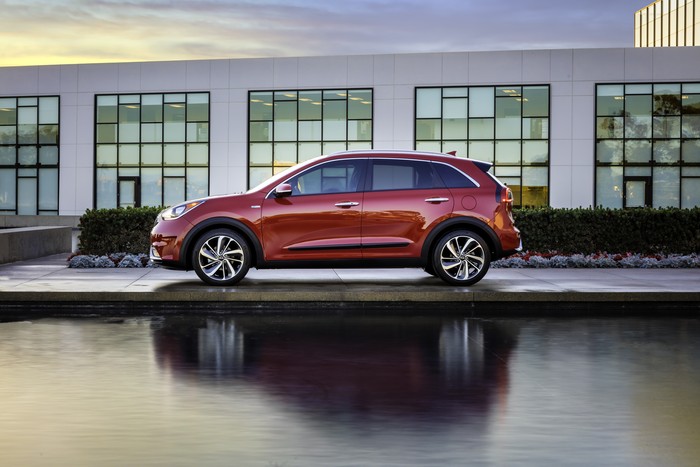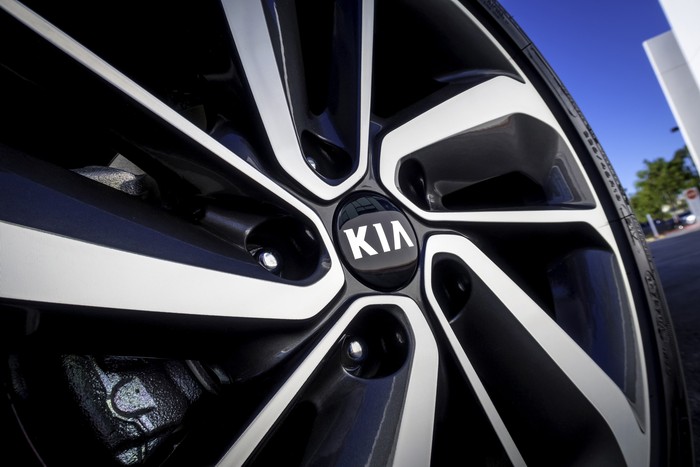

2018 Kia Niro
New for the latest model year, the Niro is the smallest member of Kia's crossover line-up. It's offered as a standard hybrid and as a more efficient plug-in hybrid.
Overview
Though somewhat unique, the Niro's styling draws inspiration from the larger Sorento, especially in the d-pillar area.
Up front, it features swept-back headlights and the company's signature "tiger nose" grille. The rear features expressive lights that appear slightly over-sized. It's not to everyone's taste, but at least it stands out without screaming "look at me, I'm a hybrid!"
Kia made the plug-in model's by making the hood, the tailgate, and select suspension components out of aluminum.
Life aboard
The Niro blurs the line between a crossover and a tall hatchback. It offers a tall seating position reminiscent of the Soul and a relatively straight-forward cabin layout that places all of the controls where the driver expects them to be.
Pop the tailgate and you'll find 19.4 cubic feet of trunk space behind the rear seats, or a spacious 54.5 cubes with the rear seats folded flat. To Kia's credit, buyers who select the plug-in model don't need to sacrifice trunk space.
Technical specifications
The standard Niro uses a gasoline-electric hybrid powertrain made up of a 1.6-liter four-cylinder engine and an electric motor. Together, the two power sources send 139 horsepower and 195 pound-feet of torque to the front wheels through a six-speed dual-clutch automatic transmission.
Fuel economy is the Niro's strongest attribute. The base model returns 52 mpg in the city, 49 mpg on the highway, and 50 in a combined cycle. It's one of the most efficient cars in America.
The plug-in hybrid model uses the same 1.6-liter as its hybrid sibling but it benefits from a more powerful electric motor and a bigger battery pack. It's less efficient than the hybrid model (its fuel economy checks in at 48, 44, and 46, respectively) but it offers up to 26 miles of electric-only range in ideal driving conditions.
Recharging the battery pack takes approximately 2.5 hours when using a 240-volt charger. Buyers who plug it into a regular 120-volt outlet will need to wait about nine hours for a full charge.
Standard and optional features
Kia offers the Niro Hybrid in four trim levels named FE, LX, EX and Touring, respectively. Note the FE is a deliberately stripped-out model that places a focus on fuel efficiency.
The base model comes with 16-inch wheels, automatic headlights, tinted windows, a tilt and telescopic steering wheel, a 4.2-inch screen in the instrument cluster, cloth upholstery, a six-way adjustable driver's seat, 60/40-split folding rear seats, dual-zone climate control, a seven-inch touch screen, Android Auto and Apple CarPlay compatibility, a four-speaker sound system, Bluetooth connectivity, and a multi-function steering wheel.
The list of standalone options includes a temporary spare tire (not available on the Touring trim), cross bars (not available on the FE trim), and a luggage net. Buyers can also add some of the features that come standard on higher trims to lower models.
The plug-in Niro comes in LX, EX, and EX Premium trims. LX models come standard with 16-inch alloy wheels, front fog lights, daytime running lights, tinted windows, roof rails, a tilt and telescopic steering wheel, a 4.2-inch screen in the instrument cluster, an auto-dimming rear-view mirror, cloth upholstery, a six-way power-adjustable driver's seat, 60/40-split folding rear seats, a leather-wrapped multi-function steering wheel, dual-zone climate control, seven-inch touch screen, Bluetooth connectivity, Android Auto and Apple CarPlay compatibility, and a USB charger for the rear passengers.
The list of optional equipment mostly mirrors that of the hybrid model.
Occupant safety
Every Niro regardless of trim level or drivetrain type comes with dual front, side, and curtain airbags in addition to a driver's knee airbag, a rollover sensor, plus stability and traction control systems.
Electronic driving aids like lane-change assist, a blind spot detection system, adaptive cruise control, and forward collision detection come standard on some models, including the top-spec hybrid and the base plug-in hybrid.
Key competitors
The Kia Niro's main rivals are not crossovers at all. They're the Hyundai Ioniq it shares many mechanical components with and the Toyota Prius.
Buyers who don't need the hybrid technology can cross-shop the Niro with the Nissan Rogue Sport, the Subaru Crosstrek, the Honda HR-V, and the Jeep Renegade.
















